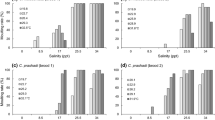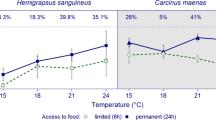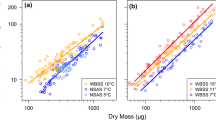Abstract
Larvae of the northern shrimp Pandalus borealis (Krøyer) are pelagic. In the Estuary and Gulf of St. Lawrence, Canada, the early stages are found in the upper 25-m of the water column in spring and early summer and are expected to experience a range of water temperatures from as low as 0°C to as high at 6°C. Little is known of the impact of water temperature on metabolic requirements of northern shrimp larvae. In this study, routine respiration (VO2), maximum respiration (electron transport system activity, ETSA) and metabolic scope for growth (MS, ETSA–VO2) of northern shrimp larvae were measured as a function of temperature (3, 5 and 8°C), developmental stage (I–V at 3°C, I–VII at 5°C and 8°C) and growth rate in dry mass. After logarithmic transformation, all three metabolic variables were linearly related to dry mass. The increase in VO2 with body mass was faster at 5°C than at 3 or 8°C, whereas with ETSA this increase was slower. As a result, MS increased more slowly with dry mass at 5°C than at 3 and 8°C. However, MS did not limit growth in this study, since it explained only 39% of the variability in growth. All three metabolic variables as well as growth varied together as a function of temperature and ontogeny. Q10 of all three metabolic variables ranged from 1.6 and 2.2 for stages I–V larvae, except for VO2 at stage I (3.9) and stage III (2.9).




Similar content being viewed by others
References
Anger K (1986) Changes of respiration and biomass of spider crab (Hyas araneus) larvae during starvation. Mar Biol 90:261–269
Anger K (2001) The biology of decapod crustacean larvae. Crustacean Issues 14. Balkema, Lisse
Anger K, Storch V, Anger V, Capuzzo JM (1985) Effects of starvation on moult cycle and hepatopancreas of Stage I lobster (Homarus americanus) larvae. Helgol Meeresunters 39:107–116
Anger K, Harms J, Montu M, Bakker C (1989) Growth and respiration during the larval development of a tropical spider crab, Libinia ferreirae (Decapoda: Majidae). Mar Ecol Prog Ser 54:43–50
Bergström BI (2000) The biology of Pandalus. Adv Mar Biol 38:57–253
Finn RN, Rønnestad I, Meeren Tvd, Fyhn HJ (2002) Fuel and metabolic scaling during the early life stages of Atlantic cod Gadus morhua. Mar Ecol Prog Ser 243:217–234
Fry FEJ (1971) The effect of environmental factors on the physiology of fish. In: Hoar WS, Randall DJ (eds) Environmental relations and behavior. Academic, New York, pp 1–98
Jacobi CC, Anger K (1985) Effect of temperature on respiration of larval stages of Hyas araneus and H. coarctatus (Decapoda, Majidae). Mar Ecol Prog Ser 26:181–186
Kleiber M (1947) Body size and metabolic rate. Physiol Rev 27:511–541
Levy EM, Cunningham CC, Conrad CDW, Moffatt JD (1977) A titration apparatus for the determination of dissolved oxygen in seawater. J Fish Res Bd Can 34:2218–2220
Ouellet P, Chabot D (2005) Rearing Pandalus borealis larvae in the laboratory. Part I. Development and growth at three temperatures. Mar Biol (in press)
Ouellet P, Lefaivre D (1994) Vertical distribution of northern shrimp (Pandalus borealis) larvae in the Gulf of St. Lawrence; implications for trophic interactions and transport. Can J Fish Aquat Sci 51:123–132
Ouellet P, Lefaivre D, Koutitonsky V (1990) Distribution of shrimp (Pandalus borealis) larvae and hydrographic pattern in the northern Gulf of St. Lawrence. Can J Fish Aquat Sci 47:2068–2078
Packard TT, Williams PJ (1981) Rates of respiratory oxygen consumption and electron transport in surface seawater from the northwest Atlantic. Oceanol Acta 4:351–358
Paul AJ, Nunes P (1983) Temperature modification of respiratory metabolism and caloric intake of Pandalus borealis (Kroeyer) first zoeae. J Exp Mar Biol Ecol 66:163–168
Peters RH (1983) The ecological implications of body size. Cambridge University Press, Cambridge, UK
Quinn GP, Keough MJ (2002) Experimental design and data analysis for biologists. Cambridge University Press, Cambridge, UK
Saotome K, Ikeda T (1990) Body composition and metabolism of the larvae of the pink shrimp (Pandalus borealis Kroeyer) raised in the laboratory. Bull Jpn Sea Natl Fish Res Inst 40:67–77
Savard L, Bouchard H, Couillard P (2003) Revue de la pêche à la crevette nordique (Pandalus borealis) dans l’estuaire et le golfe du Saint-Laurent pour la période 1965–2000. Rapp Tech Can Sci Halieut Aquat 2465
Savenkoff C, Saint-Amand L, Ouellet P, Packard TT (1995) An index of respiratory efficiency in the shrimp Pandalus borealis (Krøyer) larvae. Can Tech Rep Fish Aquat Sci 2072
Schmidt-Nielsen K (1984) Scaling: why is animal size so important. Cambridge University Press, Cambridge, UK
Schmidt-Nielsen K (1990) Animal physiology: adaptation and environment. 4th edn. Cambridge University Press, Cambridge, UK
Shumway SE, Perkins HC, Schick FS, Stickney AP (1985) Synopsis of biological data on the pink shrimp, Pandalus borealis Krøyer, 1838. NOAA Tech Rep NMFS 30
Sokal RR, Rohlf FJ (1995) Biometry — The principles and practice of statistics in biological research. Freeman, New York
St-Amand L, Gagnon R, Packard TT, Savenkoff C (1999) Effects of inorganic mercury on the respiration and the swimming activity of shrimp larvae, Pandalus borealis. Comp Biochem Physiol C Comp Pharmacol 122:33–43
Acknowledgements
We are very grateful to Jean-Pierre Allard for his able handling of the rearing of P. borealis larvae, to Roberta Miller and Véronique Allard for performing the measurements of routine respiration, and to Nathalie Côté for the determinations of ETSA and total protein contents. We also thank Roberta Miller for reviewing the manuscript. These experiments followed the recommendations of the Canadian Council for the Protection of Animals.
Author information
Authors and Affiliations
Corresponding author
Additional information
Communicated by R.J. Thompson, St. John’s
Rights and permissions
About this article
Cite this article
Chabot, D., Ouellet, P. Rearing Pandalus borealis larvae in the laboratory. Marine Biology 147, 881–894 (2005). https://doi.org/10.1007/s00227-005-1626-5
Received:
Accepted:
Published:
Issue Date:
DOI: https://doi.org/10.1007/s00227-005-1626-5




